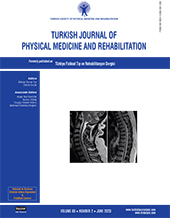The effect of mirror therapy on lower extremity motor function and ambulation in post-stroke patients: A prospective, randomized-controlled study
2 Department of Physical Medicine and Rehabilitation, Bülent Ecevit University Faculty of Medicine, Zonguldak, Turkey
3 Department of Physical Medicine and Rehabilitation, Gaziosmanpaşa Taksim Training and Research Hospital, Istanbul, Turkey DOI : 10.5606/tftrd.2020.2719 Objectives: This study aims to evaluate the effects of mirror therapy (MT) on lower extremity motor function and ambulation in post-stroke patients.
Patients and methods: A total of 42 post-stroke patients (25 males, 17 females; mean age 58 years; range, 32 to 71 years) were included. All patients were randomly divided into two groups as the control group (n=21) receiving a conventional rehabilitation program for four weeks (60 to 120 min/day for five days a week) and as the MT group (n=21) receiving MT for 30 min in each session in addition to the conventional rehabilitation program. The Brunnstrom stages of stroke recovery, Functional Independence Measure (FIM), Berg Balance Scale (BBS) and Motricity Index (MI) scores, six-minute walking test (6MWT), Functional Ambulation Category (FAC), and the degree of ankle plantar flexion spasticity using the Modified Ashworth Scale (MAS) were evaluated at baseline (Day 0), at post-treatment (Week 4), and eight weeks after the end of treatment (Week 12).
Results: There were significant differences in all parameters between the groups, except for the degree of ankle plantar flexion spasticity, and in all time points between Week 0 and 4 and between Week 0 and 12 (p<0.05).
Conclusion: These results suggest that MT in addition to conventional rehabilitation program yields a greater improvement in the lower extremity motor function and ambulation, which sustains for a short period of time after the treatment.
Keywords : Lower extremity, mirror therapy, motor impairment, neurorehabilitation, stroke

















